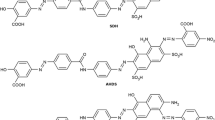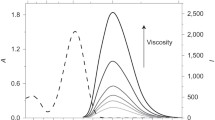Abstract
Despite significant progress in understanding of dye aggregation, there are still processes that need to be further explored and which can significantly affect aggregation. In this work it was shown that the aggregation of dyes is influenced not only by dye concentration, but also by solvent polarity. It was found that nature, positions and number of fluorescent peaks may be controlled by simultaneous varying of both water fraction and dye concentration. This effect is most pronounced for molecular rotors, which aggregates’ geometry may be stabilized in different separate states depending on the aggregation degree. The concentration effect plays a significant role in dye aggregation and should be considered in new studies in order to prevent misinterpretation or to obtain new results in fields of molecular sensing or fine-tuning of fluorescence color. In this paper aggregation caused spectral changes are discussed in line with the dye structure preorganization as the strategy for the fine tuning of practically valuable spectral characteristics.














Similar content being viewed by others
References
Loudet A, Burgess K (2007) BODIPY dyes and their derivatives: syntheses and spectroscopic properties. Chem Rev 107:4891–4932. https://doi.org/10.1021/cr078381n
Rezende LCDDL, Emery S, Emery F (2013) A review of the synthetic strategies for the development of BODIPY dyes for conjugation with proteins. Orbital Elec J Chem 5:62–83. https://doi.org/10.17807/orbital.v5i1.482
Solomonov AV, Marfin YS, Rumyantsev EV (2019) Design and applications of dipyrrin-based fluorescent dyes and related organic luminophores: from individual compounds to supramolecular self-assembled systems. Dyes Pigments 162:517–542. https://doi.org/10.1016/j.dyepig.2018.10.042
Ulrich G, Ziessel R, Harriman A (2008) The chemistry of fluorescent bodipy dyes: versatility unsurpassed. Angew Chem Int Ed 47:1184–1201. https://doi.org/10.1002/anie.200702070
Marfin YS, Shipalova MV, Kurzin VO, Ksenofontova KV, Solomonov AV, Rumyantsev EV (2016) Fluorescent properties of BODIPY sensors based on Photoinduced Electron transfer. J Fluoresc 26:2105–2112. https://doi.org/10.1007/s10895-016-1905-1
Marfin YS, Merkushev DA, Usoltsev SD, Shipalova MV, Rumyantsev EV (2015) Fluorescent properties of 8-substituted BODIPY dyes: influence of solvent effects. J Fluoresc 25:1517–1526. https://doi.org/10.1007/s10895-015-1643-9
Marfin YS, Merkushev DA, Levshanov GA, Rumyantsev EV (2014) Fluorescent properties of 8-phenylbodipy in ethanol - ethylene glycol mixed solutions. J Fluoresc 24:1613–1619. https://doi.org/10.1007/s10895-014-1447-3
Goze C, Ulrich G, Charbonnière L, Cesario M, Prangé T, Ziessel R (2003) Cation sensors based on terpyridine-functionalized boradiazaindacene. Chem - A Eur J 9:3748–3755. https://doi.org/10.1002/chem.200305084
Merkushev DA, Usoltsev SD, Marfin YS, Pushkarev AP, Volyniuk D, Grazulevicius JV, Rumyantsev EV (2017) BODIPY associates in organic matrices: spectral properties, photostability and evaluation as OLED emitters. Mater Chem Phys 187:104–111. https://doi.org/10.1016/j.matchemphys.2016.11.053
Mueller T, Gresser R, Leo K, Riede M (2012) Organic solar cells based on a novel infrared absorbing aza-bodipy dye. Sol Energy Mater Sol Cells 99:176–181. https://doi.org/10.1016/j.solmat.2011.11.006
Marfin YS, Usoltsev SD, Kazak AV, Smirnova AI, Rumyantsev EV, Molchanov EE, Kuznetsov VV, Chumakov AS, Glukhovskoy EG (2017) Synthesis and spectral properties of preorganized BODIPYs in solutions and Langmuir-Schaefer films. Appl Surf Sci 424:228–238. https://doi.org/10.1016/J.APSUSC.2017.04.014
Hong Y, Lam JWY, Tang BZ (2011) Aggregation-induced emission. Chem Soc Rev 40:5361–5388. https://doi.org/10.1039/c1cs15113d
Sharnoff M (1971) Photophysics of aromatic molecules. J Lumin 4:69–71. https://doi.org/10.1016/0022-2313(71)90011-1
Wang J, Zhao Y, Dou C, Sun H, Xu P, Ye K, Zhang J, Jiang S, Li F, Wang Y (2007) Alkyl and dendron substituted quinacridones: synthesis, structures, and luminescent properties. J Phys Chem B 111:5082–5089. https://doi.org/10.1021/jp068646m
Hecht S, Fréchet JMJ (2001) Dendritic encapsulation of function: applying nature’s site isolation principle from biomimetics to materials science. Angew Chem Int Ed 40:74–91. https://doi.org/10.1002/1521-3773(20010105)40:1<74::AID-ANIE74>3.0.CO;2-C
Luo J, Xie Z, Xie Z, Lam JWY, Cheng L, Chen H, Qiu C, Kwok HS, Zhan X, Liu Y, Zhu D, Tang BZ (2001) Aggregation-induced emission of 1-methyl-1,2,3,4,5-pentaphenylsilole. Chem Commun 18:1740–1741. https://doi.org/10.1039/b105159h
Hong Y, Lam JWY, Tang BZ (2009) Aggregation-induced emission: phenomenon, mechanism and applications. Chem Commun:4332–4353. https://doi.org/10.1039/b904665h
Tang BZ, Zhan X, Yu G, Sze Lee PP, Liu Y, Zhu D (2001) Efficient blue emission from siloles. J Mater Chem 11:2974–2978. https://doi.org/10.1039/b102221k
Jing H, Lu L, Feng Y, Zheng JF, Deng L, Chen EQ, Ren XK (2016) Synthesis, aggregation-induced emission, and liquid crystalline structure of tetraphenylethylene-surfactant complex via ionic self-assembly. J Phys Chem C 120:27577–27586. https://doi.org/10.1021/acs.jpcc.6b09901
Eisfeld A, Briggs JS (2006) The J- and H-bands of organic dye aggregates. Chem Phys 324:376–384. https://doi.org/10.1016/j.chemphys.2005.11.015
Bonardi L, Kanaan H, Camerel F, Jolinat P, Retailleau P, Ziessel R (2008) Fine-tuning of yellow or red photo- and electroluminescence of functional difluoro-boradiazaindacene films. Adv Funct Mater 18:401–413. https://doi.org/10.1002/adfm.200700697
Mikhalyov I, Gretskaya N, Bergström F, Johansson LB (2002) Electronic ground and excited state properties of dipyrrometheneboron difluoride (BODIPY): dimers with application to biosciences. Phys Chem Chem Phys 4:5663–5670. https://doi.org/10.1039/b206357n
Tokoro Y, Nagai A, Chujo Y (2010) Nanoparticles via H-aggregation of amphiphilic BODIPY dyes. Tetrahedron Lett 51:3451–3454. https://doi.org/10.1016/j.tetlet.2010.04.120
Choi S, Bouffard J, Kim Y (2014) Aggregation-induced emission enhancement of a meso-trifluoromethyl BODIPY via J-aggregation. Chem Sci 5:751–755. https://doi.org/10.1039/c3sc52495g
Yang Y, Guo Q, Chen H, Zhou Z, Guo Z, Shen Z (2013) Thienopyrrole-expanded BODIPY as a potential NIR photosensitizer for photodynamic therapy. Chem Commun 49:3940–3942. https://doi.org/10.1039/c3cc40746b
Hu R, Lager E, Aguilar-Aguilar A, Liu J, Lam JWY, Sung HHY, Williams ID, Zhong Y, Wong KS, Peña-Cabrera E, Tang BZ (2009) Twisted intramolecular charge transfer and aggregation-induced emission of BODIPY derivatives. J Phys Chem C 113:15845–15853. https://doi.org/10.1021/jp902962h
Manzano H, Esnal I, Marqués-Matesanz T, Bañuelos J, López-Arbeloa I, Ortiz MJ, Cerdán L, Costela A, García-Moreno I, Chiara JL (2016) Unprecedented J-aggregated dyes in pure organic solvents. Adv Funct Mater 26:2756–2769. https://doi.org/10.1002/adfm.201505051
Mukherjee S, Thilagar P (2014) Fine-tuning dual emission and aggregation-induced emission switching in NPI-BODIPY dyads. Chem - A Eur J 20:9052–9062. https://doi.org/10.1002/chem.201305049
Baglan M, Ozturk S, Gür B, Meral K, Bozkaya U, Bozdemir OA, Atilgan S (2013) Novel phenomena for aggregation induced emission enhancement: highly fluorescent hydrophobic TPE-BODIPY couples in both organic and aqueous media. RSC Adv 3:15866–15874. https://doi.org/10.1039/c3ra40791h
Tian D, Qi F, Ma H, Wang X, Pan Y, Chen R, Shen Z, Liu Z, Huang L, Huang W (2018) Domino-like multi-emissions across red and near infrared from solid-state 2−/2,6-aryl substituted BODIPY dyes. Nat Commun 9:1–9. https://doi.org/10.1038/s41467-018-05040-8
Wan Y, Li J, Peng X, Huang C, Qi Q, Lai WY, Huang W (2017) Intramolecular charge transfer induced emission from triphenylamine-o-carborane dyads. RSC Adv 7:35543–35548. https://doi.org/10.1039/c7ra06237k
Marfin YS, Vodyanova OS, Merkushev DA, Usoltsev SD, Kurzin VO, Rumyantsev EV (2016) Effect of π-extended substituents on Photophysical properties of BODIPY dyes in solutions. J Fluoresc 26:1975–1985. https://doi.org/10.1007/s10895-016-1891-3
Betancourt-Mendiola L, Valois-Escamilla I, Arbeloa T, Bañuelos J, López Arbeloa I, Flores-Rizo JO, Hu R, Lager E, Gómez-Durán CFA, Belmonte-Vázquez JL, Martínez-González MR, Arroyo IJ, Osorio-Martínez CA, Alvarado-Martínez E, Urías-Benavides A, Gutiérrez-Ramos BD, Tang BZ, Peña-Cabrera E (2015) Scope and limitations of the liebeskind-srogl cross-coupling reactions involving the biellmann BODIPY. J Organomet Chem 80:5771–5782. https://doi.org/10.1021/acs.joc.5b00731
Li Q, Qian Y (2016) Aggregation-induced emission enhancement and cell imaging of a novel (carbazol-: N -yl)triphenylamine-BODIPY. New J Chem 40:7095–7101. https://doi.org/10.1039/c6nj01495j
JA Riddick, WB Bunger, TK Sakano (1986). Organic solvents: physical properties and methods of purification. Fourth edition
Kiyohara O, D’Arcy PJ, Benson GC (1978) Thermal expansivities of water + tetrahydrofuran mixtures at 298.15 K. Can J Chem 56:2803–2807. https://doi.org/10.1139/v78-463
M Margreth, R Schlink, A Steinbach, M Margreth, R Schlink, A Steinbach (2010). Water Determination By Karl Fischer Titration, In: Pharm. Sci. Encycl., Wiley. Hoboken, NJ, USA. https://doi.org/10.1002/9780470571224.pse415
Kubista M, Sjöback R, Eriksson S, Albinsson B (1994) Experimental correction for the inner-filter effect in fluorescence spectra. Analyst. 119:417–419. https://doi.org/10.1039/AN9941900417
Ravindran E, Varathan E, Subramanian V, Somanathan N (2016) Self-assembly of a white-light emitting polymer with aggregation induced emission enhancement using simplified derivatives of tetraphenylethylene. J Mater Chem C 4:8027–8040. https://doi.org/10.1039/c6tc02566h
Struganova IA, Hazell M, Gaitor J, McNally-Carr D, Zivanovic S (2003) Influence of inorganic salts and bases on the J-band in the absorption spectra of water solutions of 1,1′-Diethyl-2,2′-cyanine iodide. J Phys Chem A 107:2650–2656. https://doi.org/10.1021/jp0223004
On C, Tanyi EK, Harrison E, Noginov MA (2017) Effect of molecular concentration on spectroscopic properties of poly(methyl methacrylate) thin films doped with rhodamine 6G dye. Opt Mater Express 7:4286. https://doi.org/10.1364/ome.7.004286
Funding
This work was supported by the grant of the President of the Russian Federation for state support of scientific research of young Russian scientists MK-1098.2019.3.
Author information
Authors and Affiliations
Contributions
Yuriy S. Marfin: Conceptualization, Methodology, Writing - Original Draft, Writing - Review & Editing, Supervision, Project Administration, Funding Acquisition. Elizaveta A. Banakova: Conceptualization, Methodology, Validation, Investigation, Writing - Original Draft, Writing - Review & Editing, Visualization, Funding Acquisition. Dmitry A. Merkushev: Conceptualization, Methodology, Software, Investigation, Writing - Original Draft, Writing - Review & Editing, Visualization, Funding Acquisition. Sergey D. Usoltsev: Investigation. Andrei V. Churakov: Investigation.
Corresponding author
Additional information
Publisher’s Note
Springer Nature remains neutral with regard to jurisdictional claims in published maps and institutional affiliations.
Highlights
• The simultaneous influence of dye concentration and solvent polarity on aggregation processes has been revealed.
• The way to change and control dye spectral characteristics by aggregation has been studied.
• The analysis of spectral and aggregation properties was carried out in THF-Water mixtures with different water fractions and dye concentrations.
Rights and permissions
About this article
Cite this article
Marfin, Y.S., Banakova, E.A., Merkushev, D.A. et al. Effects of Concentration on Aggregation of BODIPY-Based Fluorescent Dyes Solution. J Fluoresc 30, 1611–1621 (2020). https://doi.org/10.1007/s10895-020-02622-y
Received:
Accepted:
Published:
Issue Date:
DOI: https://doi.org/10.1007/s10895-020-02622-y




